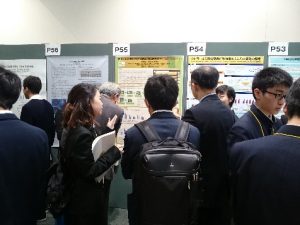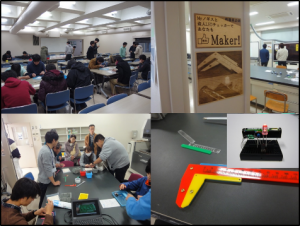System Design Innovation Center
1.System Design Innovation Center

According to the Japanese White Paper on Science and Technology, the mission of science and technology is to produce innovation in the social economy and to contribute to the sustainable development of society due to a concern that Japan’s vitality and international competitiveness will decline as a result of the rapidly declining birthrate and aging of the population. Faced with larger and more complicated issues such as environmental and energy problems, engineers should acquire facilitation skills to lead innovative solutions as soon as possible.
Our center was established in 2015 based on the principles “To teach is to learn” and “Regional symbiosis.” The mission is to promote education that cultivates student facilitation skills related to technological innovation, as well as innovative multidisciplinary research with diversified staff who acquire facilitation skills by engaging in that education. Facilitation skills are generic skills like communication and teamwork, etc. We will develop our facilitation skills by promoting innovative multidisciplinary research in cooperation with each other and explore educational methods that produce engineers who provide attractive and practical solutions for society. To do so, we will conduct the multidisciplinary educational course, “System Design Education Program,” supervised by Prof. Nishimura and Prof. Takahashi of Keio University. The course is also supported by 20 regional partner companies. Some course classes are designed based on our original JSCOOP educational approach, which cultivates innovators with the ability to identify and solve problems in our regional area as a learning field.
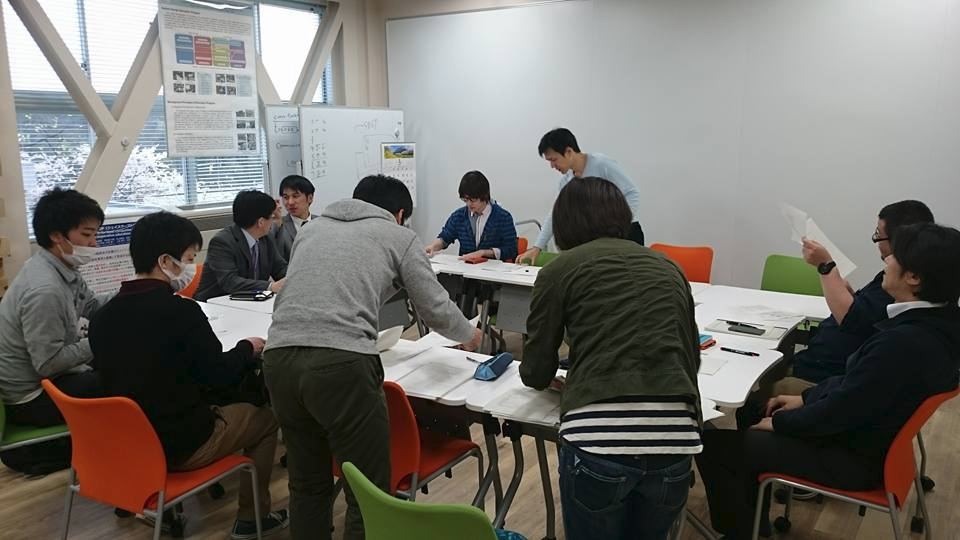
2. Organization and tasks
(1) Organization

(2) Primary tasks
- Promotion of innovative education and research based on system thinking and design thinking
- Promotion of multidisciplinary education and research
- Development of the results of the above two tasks in our college
- Other tasks related to research promotion and support
(3) Facilities


Fig. 3 System Design Innovation Center Facilities
3. System Design Education Program
(1) “System Design Education Program” multidisciplinary educational course
Our college conducts a multidisciplinary educational course to produce creative and practical engineers who can solve complicated tasks by utilizing a wide range of technical knowledge and skills based on lateral thinking. The curriculum of the multidisciplinary educational course consists of a Basic Course in the fourth and fifth grades of associate degree programs and an Expert Course in the first and second grades of the advanced course. The curriculum is managed by staff outside of the department so that students taking the course may acquire the ability to integrate the knowledge and skills associated with their own specialized fields into those of different fields.
The “System Design Education Program” was established as a program of the multidisciplinary course in 2014. The education program cultivates facilitation skills for devising solutions to multidisciplinary problems, such as relief system design (for people) or safety system design (for things).

(2) “Relief system design (for people)” innovative multidisciplinary research
Example of research theme 1: Improvement and support for usability of automobiles and ships
Background: The by-wire technique, developed for aircraft, will be applied to automobiles and ships to improve their usability.
Keywords: Human-machine interface, Mechatronics, Usability
Example of research theme 2: Development of sports instruction with a humanoid robot
Background: Research on human-robot interaction has been actively conducted. A new sports training method with a humanoid robot has been investigated by our group.
Keywords: Human-robot interaction, Mechatronics, Robotics, Sports training, Cognitive science
(3) “Safety system design (for things)” innovative multidisciplinary research
Example of research theme: Health monitoring and smart maintenance of concrete structures
Background: It is expected that infrastructure developed during the high growth period will have rapidly deteriorated in the future, and countermeasures are urgently required. Some smart methods using multidisciplinary technology have been proposed by our group.
Keywords: Infrastructure, Concrete structure, Health monitoring, Smart maintenance, Mechatronics, Robotics, Cognitive science, IoT, AI
4. Engineering Design Education
(1) Engineering Design Education

Rapid progress in science and technology and the globalization of industry increase the demand for education of engineers who can be active internationally. Having identified weaknesses in engineering design education, Japanese higher education institutions have made numerous efforts to improve it. Various definitions of engineering design education are roughly divided into the following three abilities cultivated by active learning.
・Design ability: Ability to solve social needs by using various technologies and information
・Ability to carry out projects: Ability to plan and work together within given constraints
・Team activity abilities: Ability to work in a team
Through the unification of various exercises and experiments similar to active learning, Nagaoka College launched Engineering Design Education as a special experiment in the first grade of the advanced course beginning in 2013. It is managed by our center as a self-development subject study within the “System Design Education Program.”
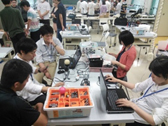


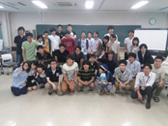
(2) Self-development subject
Course objective
・Students will be able to define the problem to be solved after considering health, safety, culture, society, and public environment issues based on real situations, and will acquire the basic skills necessary for collecting, analyzing, and organizing information to solve the problem.
・In unprecedented cases, students will be able to objectively and logically grasp the issues, compare effects and values, and select the best option.
・Students will be able to select dictation, descriptions, charts, graphics, etc. in communication.
・Students will be able to understand the basic methods of consensus building and individual roles in groups for consensus building, as well as the leaders’ roles and teamwork for organizations consisting of diverse members.
Table 1 Class contents of Self-development subject
| Week | Content |
|---|---|
| 1 | Guidance. What is logical thinking? |
| 2 | Basic method and tools for logical thinking |
| 3 | Pyramid structure |
| 4 | Logic tree |
| 5 | Framework-type tool and flow-type tool |
| 6 | What is facilitation for engineering? |
| 7 | Meeting to facilitate engineering |
| 8 | Meeting skills such as consensus building and problem solving |
| 9 | Planning process |
| 10 | Engineering design exercise, Design theme |
| 11 | Engineering design exercise, Analysis |
| 12 | Engineering design exercise, Planning |
| 13 | Engineering design exercise, Preparation for presentation |
| 14 | Engineering design exercise, Planning presentation |
| 15 | Report creation and summary |
(3) Engineering Design Exercise (First grade of advanced course)
Course objective
・Students will be able to understand the design method.
・Students will be able to understand how to work in a group according to their plan.
・Students will continuously acquire learning habits on their own initiative.
Table 2 Class contents of Self-development subject
| Week | Content |
|---|---|
| 1 | Guidance; Dividing students into groups; Ice-breaker 1; Lecture and practice of meeting methods for engineering facilitation |
| 2 | Lecture and practice of consensus building for engineering facilitation; Ice-breaker 2 |
| 3 | Lecture and practice “What is planning?” |
| 4 | Explanation of design theme; Planning |
| 5 | Planning |
| 6 | Preparation for presentation of planning |
| 7 | Presentation of planning |
| 8 | Trial-based PDCA cycle |
| 9 | Trial-based PDCA cycle |
| 10 | Design review |
| 11 | Trial-based PDCA cycle |
| 12 | Trial-based PDCA cycle |
| 13 | Final examination and evaluation |
| 14 | Preparation for presentation of outcome |
| 15 | Presentation of outcome |
5. JSCOOP
(1) JSCOOP
Our original JSCOOP educational approach stands for Job Contents Search for Regional Companies-based Cooperative Education. The approach cultivates innovators with the ability to detect and solve problems in regional areas as the learning field. JSCOOP proposes the following two missions to students.
[Mission 1: Making an advertisement leaflet for a regional company]
Students gather information on a regional company by collecting information on the philosophy, history, work content, and technology possessed by the company, as well as its role domestically and overseas. They create the leaflet from the viewpoint they have formulated based on their coverage. The leaflet is advertised through the Web, SNS, etc., after obtaining the consent of the company.
[Mission 2: Identifying problems of a regional company]
Students collect information on problems of a regional company and identify an issue. Using lateral thinking, they propose a solution for the problem they have identified.
(2) Regional partner companies
JSCOOP is supported by 20 partner companies in Niigata prefecture. The partner companies provide learning field, topical, and valuable advice to students from a practical perspective. The advisory committee consisting of representatives of five of the companies responds to consultations with the Director of the System Design Innovation Center.




Fig. 5 Discussion of materials collection policy Fig. 6 Confirmation of policy with regional partner companies

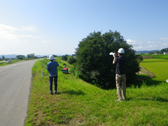


Fig. 7 Collecting materials for regional partner companies
6. Prelab system
The basic philosophy of the Prelab system is to support faculty members’ exploratory research and research activities for underclassmen, who are the equivalent of high school students (Akazawa, S. et al. 2016). The Prelab system comprises three major policies: (A) “Supporting exploratory research and realization of ideas,” (B) “Holding various seminars,” and (C) “Discussing new education methods.” In addition, all faculty members can propose contents to students and faculty members. Usually, researchers in general educational faculties and technical personnel find it difficult to conduct research because their laboratories and human resources are not based at our college; however, they can attempt to establish their own laboratory using the Prelab system. It is therefore expected that Prelab will help to increase the number of collaborative works and grant applications.
Underclassmen can also participate in laboratory research using this system if they have an interest in research activity. Generally, most of our students have had the experience of crafting / making something, as well as some experimental work. However, underclassmen do not have many experimental classes or opportunities for research activity. Some reports note that the academic motivation of certain students may gradually decline for this reason (Yoshida, M., 2008); it is therefore important to rapidly provide countermeasures. The mission of the Prelab system is to prevent this problem and keep students motivated through constructive activities. In fact, some reports note that research activity can prevent a decline in the academic motivation of underclassmen (Yoshida, M. et al. 2008, Miki, K., 2010). When the Prelab system is used effectively, there are many possible benefits for faculty members and students. The Prelab system is a tool that is well suited to enhancing educational and research activities.
References
Akazawa, S., Tawara, Y., Kiryu, T., Tokoi, Y., Tsuchida, Y. Ikeda, F., Iyama, T., Murakami, Y., and Toyama, S. (2016) Enhancement of educational and research activities using the “Prelab system.” Transactions of ISATE 2016. 460–463.
Yoshida, M. and Tomita, H. (2008). Monozukuri class lower grade students applying graduation research at technical college. Journal of the Japanese Society for Engineering Education, 56, 62–68.
Miki, K. (2010). Creative education using after-school activities. Journal of the Japan Association for College of Technology, 15, 113–118.

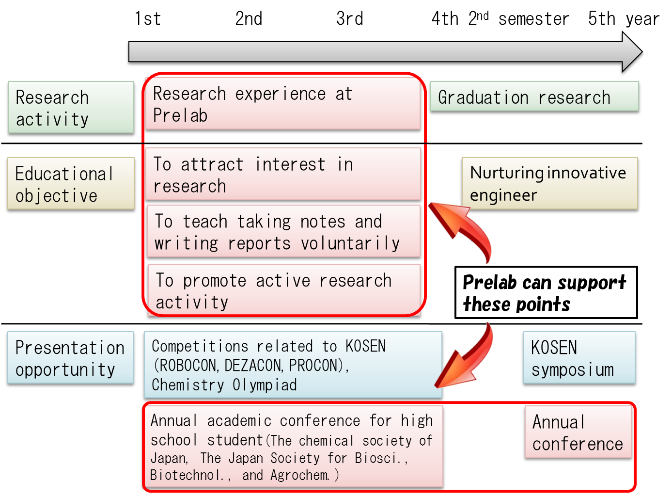
and supporting points of Prelab system


